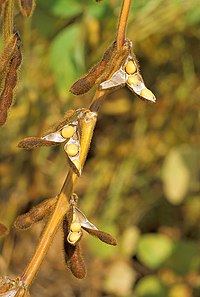
Photo from wikipedia
Abstract Un-capped, ethylenediamine-capped (EDA-capped) and L-cysteine-capped (L-cyst.-capped) ZnO nanorods (ZNRs) were synthesized from an aqueous solutions of Zn(NO3)2 and (CH2)6N4 via a two-step chemical bath deposition method at a bath… Click to show full abstract
Abstract Un-capped, ethylenediamine-capped (EDA-capped) and L-cysteine-capped (L-cyst.-capped) ZnO nanorods (ZNRs) were synthesized from an aqueous solutions of Zn(NO3)2 and (CH2)6N4 via a two-step chemical bath deposition method at a bath temperature of 90 °C for 3 h. The ZNRs were grown on a Ga-doped ZnO (GZO) seeded glass substrate. The effects of the EDA and the L-cysteine complexing agents and their concentrations (ranging from 0 to 2 mM) on the structural and optical properties of the ZNRs were studied using various techniques. The X-ray diffraction study showed that all the ZNRs that were grown had a strong c-axis preferred orientation irrespective of the capping agents used. The average crystallite sizes were approximated as 84, 77, 75, 106 and 107 nm for un-capped (0 mM), 0.5 EDA-capped, 2 mM EDA-capped, 0.5 L-cyst.-capped and 2 mM L-cyst.-capped ZNRs, respectively. Scanning electron microscope investigation of the samples showed successive decrease in the diameters and lengths of the particles with the increase in EDA-capping concentrations but an increase in particle sizes as the L-cyst.-capping levels increased. Novel changes in crystal shapes were realized at higher capping concentrations. Well-aligned, uniform and compactly packed arrays of hexagonal ZNRs were formed in the presence of the 0.5 mM L-cyst.-capping. The energy-dispersive X-ray spectroscopy analyses showed that the 0.5 mM L-cyst.-capped sample presents the Zn/O ratio to the proximity of 1. The photoluminescence (PL) and cathodoluminescence emissions spectra showed the main peaks of ZnO, which varied in similar trends with changes in the type and concentrations of the capping agents. The highest PL emission peak intensity was obtained at a capping ratio of 0 mM, and 0.5 mM L-cysteine. The values of the absorption edges observed were in the range of 384–397 nm, while the absorption peaks ranged between 361 and 372 nm. Finally, the band gap values increased from 3.32 to 3.33 eV with an increase in EDA-capping concentration; and decreased from 3.32 to 3.27 eV with an increase in the L-cyst.-capping concentration. The highly luminescent ZNRs composed of well-aligned and improved particle distributions with perfect crystallization produced at the 0.5 mM L-cyst.-capping, can be used as a possible photoanode for dye-sensitized solar cells.
Journal Title: Applied Surface Science
Year Published: 2019
Link to full text (if available)
Share on Social Media: Sign Up to like & get
recommendations!